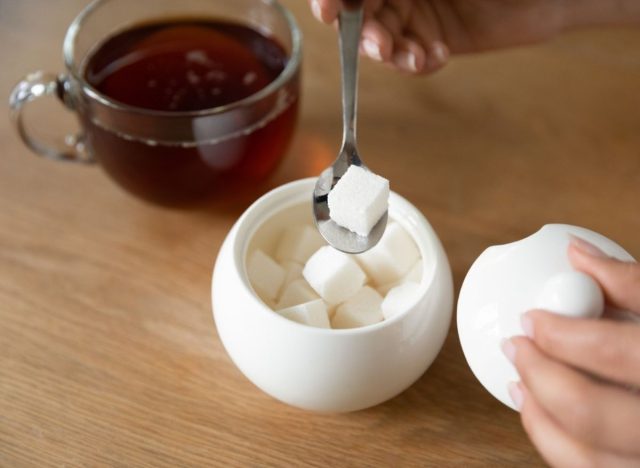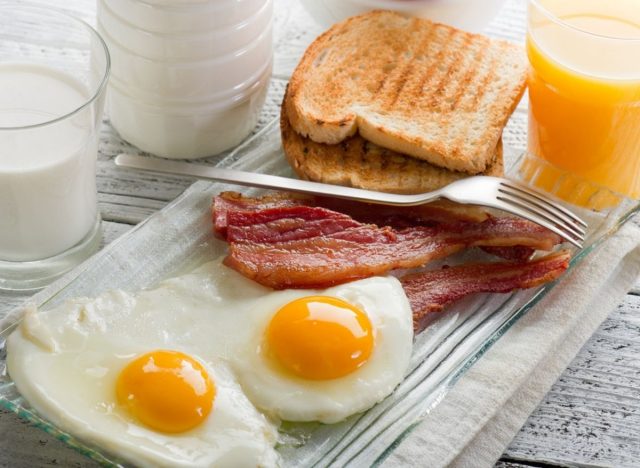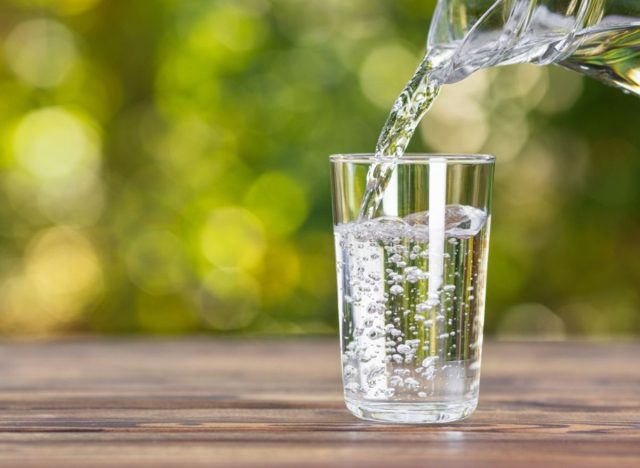Picture a pot of soup simmering on a stove. It’s not cold, and it’s not boiling. It’s simmering. This is akin to your metabolism right now while you’re sitting or standing and reading these words on your device.
Your metabolism is your body burning calories to energize all of its functions. Everything from breathing, digesting, and circulating blood, to growing hair, propelling you up a flight of stairs, and repairing cells after injury. It simmers even while you’re sleeping. This slow-burn remains mostly constant throughout your day. Body size, muscle mass, and age play a part in the speed of your metabolism, but it’s mostly set by your genes. You can pick up the pace of your metabolism to burn off calories throughout the day, calories that might otherwise end up stored as fat, including belly fat.
“The belly is one of the body’s primary areas of fat storage,” says Robert Herbst, a 46-time powerlifting champion and Olympic official, who recently broke a world record in the Yoke Carry (556 lbs.) at age 63. “Fat is stored there first and burned from there last, and unfortunately, despite what infomercials claim, we can’t spot reduce. The only way to lose belly fat is to lose overall body fat.”
What works for your overall body, then, works for your belly, and in more ways than one. Most of the things you can do to speed up your metabolism can also improve your health, fitness, energy levels, mental sharpness, and self-esteem.
So, let’s turn up the heat and look at some ways you can speed up your metabolism and burn fat! And while you’re doing that, check out the 11 Worst Foods for Your Metabolism.
“Think of fat cells as hibernating,” says Ellie Busby, a registered nutritionist in the United Kingdom and founder of the nutrition website Vojo Health. “They require very little energy to maintain because these cells are not very active.”
Exercise reduces these sluggish cells and replaces them with muscle cells, which are more active in boosting metabolism.
“Studies show that even people with a gene called ‘FTO’ that’s associated with a slower metabolism lost as much weight as people without the gene when they engaged in regular exercise for four weeks,” Busby says.

Muscle is more metabolically active than fat, so the more you have, the more calories your body will burn even at rest.
“The best way to elevate your metabolism is through resistance exercise, such as lifting weights, which raises your metabolism for 48 to 72 hours after as your body recovers from the workout,” says Herbst.
Strength training becomes even more critical to keeping your metabolism revving as you age. This is because inactive adults can experience a 3% to 8% loss of muscle mass every 10 years, accompanied by resting metabolic rate reduction and fat accumulation, according to a study by exercise physiologist Wayne Wescott, PhD, in Current Sports Medicine Reports.
This study also found that 10 weeks of resistance training may increase resting metabolic rate by 7%.

To make metabolically active muscle, the key is consistency (working out 2 to 3 times a week) and compound lifts, says Joe Johnson, owner of 9 to 5 Nutrition, a fitness coaching service for busy office workers.
Compound lifts are exercises that work multiple muscle groups at the same time, making workouts more efficient and productive.
“Focus on basic compound exercises like bench press, pull-ups, squats, deadlifts, and shoulder presses, and try to lift a little more weight or do 1 extra rep per week,” he says. Lifting this way keeps your muscles challenged for greater growth.

If you are constantly consuming calorie-rich foods and beverages, you’ll take in more calories than your metabolism can burn off. This can lead to weight gain and belly fat.
To counter that, weight-loss surgeon Jessica Cutler, MD at The Maryland Bariatric Center at Mercy in Baltimore recommends drinking unsweetened beverages, abstaining from snacking, and “allowing your pancreas and storage hormones a chance to rest between meals.”
“Eliminating any food intake after dinner until breakfast or lunch the next day allows your body a chance to use the energy it has already stored in the form of fat,” Dr. Cutler says.

By dieting and essentially starving yourself, you are forcing your metabolism to slow down and go into survival mode. That’s counterproductive.
“Constantly dieting will wreck your metabolism,” warns Lara Days, a certified personal trainer and owner of Lara Elizabeth Coaching. “When we eat more food, we support an efficient system, we have more energy to work harder in the gym, we can build more muscle, and we can burn more through TEF (thermic effect of food).”
In other words, digesting, absorbing, storing, and excreting the food you consume burns calories. About 10% of the calories from the carbohydrates and proteins you eat are used up processing what you eat and that’s part of your overall metabolism. So, eat to boost your fat burn. And make sure to increase your protein intake.
“Protein uses more energy in the digestion process,” says Days. “It also helps us retain muscle mass, which we just learned uses more energy than fat.”

While restrictive diets tend to lower metabolism, intermittent fasting can elevate metabolism. One type of intermittent fasting is limiting eating to a window of time, say, the eight hours between your first meal of the day and the last, and fasting for 16 hours, mostly overnight.
“Intermittent fasting lowers insulin levels so our bodies can tap into stored sources of fats and boost fat oxidation,” says nurse practitioner Cynthia Thurlow, founder of the Everyday Wellness Project and author of Intermittent Fasting Transformation.
Fasting can also boost growth hormones in the body, helping to build more muscle if you strength train.
“Muscle is the organ of longevity,” Thurlow says. “We want to view our muscles as glucose reservoirs, so strength training and intermittent fasting can help us balance blood sugar and insulin and contribute to fat loss.”

Not only does eating breakfast jumpstart your metabolism for the day, but studies also suggest you may consume fewer calories the rest of the day, especially if breakfast includes satiating protein.
“If weight loss is your goal, it’s important to eat a nutritious breakfast that is going to fuel your morning,” says registered dietitian Rima Kleiner, MS, RD, a blogger at Dish on Fish.
Aim to include protein, fiber, and a little heart-healthy fat, a combination that helps to keep you feeling fuller longer.
“My Turmeric Smoked Salmon Breakfast Bowl is a great way to ensure you’re getting the ideal amounts of these key macronutrients and a host of other important vitamins, minerals, and antioxidants, including turmeric, which is known for its anti-inflammatory properties,” she says. “The salmon provides protein and omega 3’s for brain and heart health, and gets you one serving closer to meeting the recommendation for 2 to 3 seafood meals each week.”

Eating foods like protein that increase your resting metabolic rate can help you burn more calories and ultimately tap into the fat stored in your belly. One type of food that works particularly well for this is anything spicy.
“I recommend all my clients to add spicy foods to their menu in order to take full advantage of this opportunity to burn additional calories outside of daily physical activity,” says certified personal trainer Ryan Ernsbarger, fitness editor of Zenmaster Wellness.
A study in PloS One demonstrated that capsaicin, the active compound in chili peppers that gives spicy foods their heat, promotes fat oxidation and provides a short-term boost in metabolism.

Another piece of the metabolism puzzle is nicknamed N.E.A.T. for non-exercise activity thermogenesis, which encompasses all the physical activity you do in a day that isn’t planned exercise.
This can include pretty much anything, from washing dishes, mowing the lawn, tapping your foot to an upbeat tune, fidgeting in your seat in economics class, and even sex.
To boost your daily N.E.A.T., simply “move more,” says David Smithey, a Level 1 Certified Nutrition Coach and owner of Resolve Nutrition.
“My favorite metabolism booster is recommending 10-minute walks after each meal, which also improves insulin sensitivity,” he says.

As long as you don’t load it up with cream, tons of sugar, and squirts of those sweet flavorings that are popular at coffee shops, your coffee cup can deliver a daily boost to your metabolism, too.
“Caffeine elevates metabolism by increasing thermogenesis via its effects on brown adipose tissue,” says Busby of Vojo Health.
If you want an even greater metabolic response, she says, drink caffeinated green tea. Studies show that a green tea-caffeine mixture improves weight maintenance through thermogenesis and fat oxidation. And powerful antioxidant compounds in green tea called catechins may stimulate the body to burn more fat, studies suggest.

“Your body is 80% water; if you don’t drink enough, your cortisol levels (a stress hormone) will be raised, which will keep you from being able to reduce tummy fat,” says doctor of chiropractic Susan Wong, DC, co-founder of Twin Waves Wellness Center. Wong recommends women consume 2 to 3 liters per day, and 3 to 4 liters daily for men.

Exercise is good for boosting your metabolism, and vigorous exercise is even better because you use more oxygen while huffing and puffing, and your metabolism stays at that higher-rate state long after you hit the showers.
The technical term for this phenomenon is EPOC, which stands for excess post-exercise oxygen consumption. High Intensity Interval Training (HIIT), which is characterized by short bouts of very rigorous effort interspersed with intervals of resting/recovery activity, has been shown to boost EPOC.
A 2021 study in the International Journal of Exercise Science found that both vigorous strength training and HIIT sessions significantly increased energy expenditure for 14 hours after the exercise sessions were complete.

“Getting enough sleep each night is essential to maintaining your metabolism and keeping belly fat away,” says Janet Coleman, RD, a registered dietitian with The Consumer Mag.
One study in the research journal Obesity showed that sleeping only 4 hours per night for 5 nights significantly reduced morning resting metabolic rate in healthy adults.
“Aim for at least seven hours a night and try to get your last meal of the day at least three hours before bedtime so your body has time to fully digest it,” Coleman recommends.
For more strategies that may help you lose your belly, check out these Abdominal Fat-Shrinking Secrets that Actually Work.


